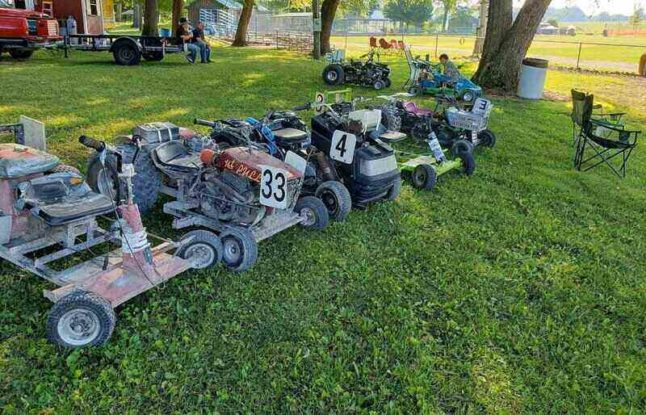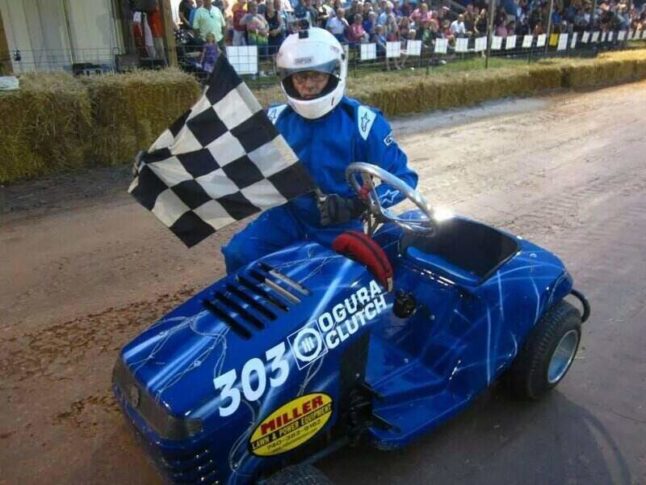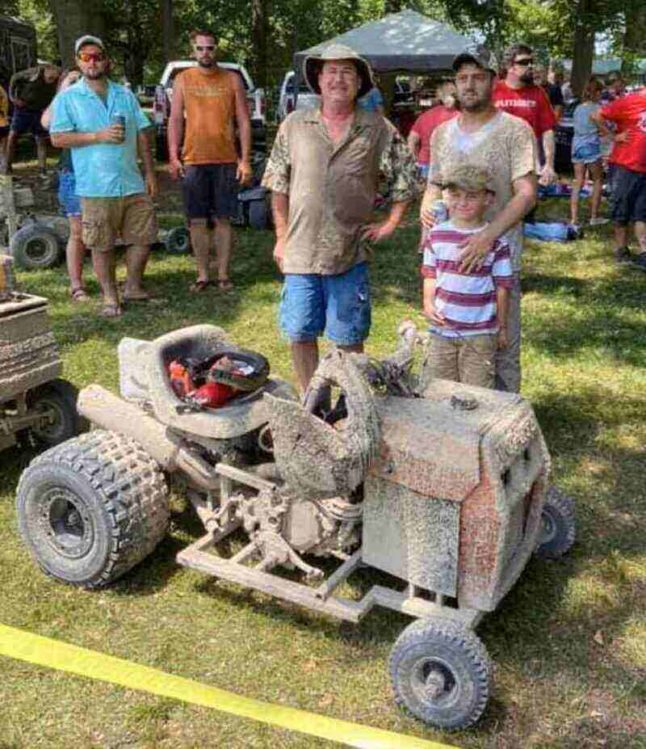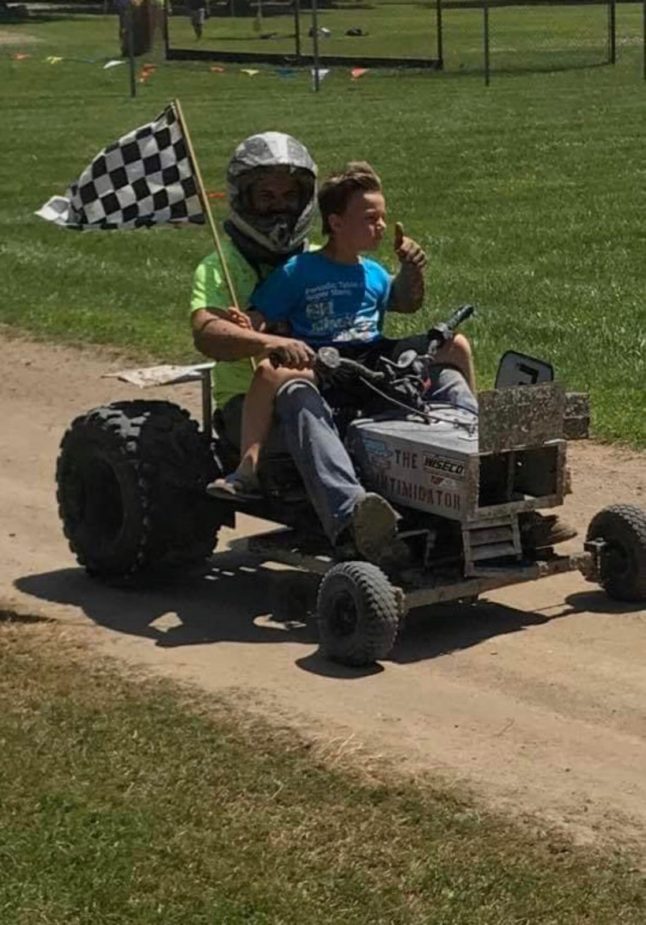
“Who hasn’t looked at a lawn mower and thought Gee, what if I was sitting on that doing 80 miles an hour?” That’s the thought process of Joe Troyer, a man who’s been racing lawn mowers for about 20 years now.
Troyer – and his fellow lawn mower racers around the world – are a unique breed. Most of us who didn’t grow up around lawn mower racing had no idea this grassroots motorsport even existed. But it’s international, and it’s been around for decades.
Go ahead and laugh. Even the most die-hard lawn mower racing enthusiasts know you have to have a sense of humor to be involved in something like this. But what you may not know if you’ve never experienced the sport up-close and personal is how much work and how much love goes into it.
“You can watch videos, you can read about it, and all that stuff,” says Kerry Evans, president of the U.S. Lawn Mower Racing Association. But you won’t truly understand “until you’re standing beside that track, and you hear that loud motor coming by and feel that vibration, and say, Man, I’ve never seen a lawn mower go that fast.“
Lawn mower racing might sound like a joke at first, but take a look under the hood. You’ll find a supportive community of people who love what they do – and love helping newcomers get involved, too.
So, what exactly is lawn mower racing? Who are the people racing lawn mowers? We’ve got all the dirt.
The Roots of Lawn Mower Racing
The first lawn mower race took place in 1963 in a tiny town called Twelve Mile, Indiana. But that race, dubbed the Twelve Mile 500, and run on every July 4, was only the beginning.
In 1973, a group of motorsports enthusiasts in the UK got together and started the first national mower racing league, the British Lawn Mower Racing Association (BLMRA). Word spread, and in 1992, the U.S. followed suit with its own United States Lawn Mower Racing Association (USLMRA).

From the beginning, this sport was far more wholesome than you might imagine. The whole point of that first lawn mower racing league in Britain was to create an equal playing field for everyone, no matter where they come from or how much money they make.
Lawn mower racing has never been about the money. All the proceeds of those early races went to local charities, and most races today still give their profits back to the local community.
Want to know more about how lawn mower racing came to be? Check out LawnStarter’s History of Lawn Mower Racing.
Lawn Mower Racing Today
While the original spirit and core values of the lawn mower racing community have persevered through time, the sport itself has come a lawn way since those early days. Watch any YouTube video that pops up when you search “lawn mower racing,” and you’ll see feats people couldn’t have dreamed of in the ‘60s and ‘70s.
Mowers speeding at more than 100 mph, races that last for 12 hours straight, young kids racing alongside their parents – it’s insane, and it’s beaut-turf-ful. These are just a few highlights of what today’s lawn mower racing looks like, but there’s a whole world to explore if you want in on this wild ride.
The Machines

If you’ve ever cut your grass with a riding lawn mower, you know they usually move at about 6 or 7 mph, maybe 10 mph if you really push it. So … how on turf do the mowers in these races go so fast?!
These aren’t your garden-variety lawn mowers. They started out as the same models you can find at Lowe’s or Home Depot, sure, but they’ve been modified since then, usually by the racers themselves.
For many participants, building impressive engines is as important to the sport as the racing itself.
Kerry Evans owned a small engine repair shop before he ever even heard of lawn mower racing. He got involved for the first time when a customer came in asking him to build an engine for a racing lawn mower. 25 years later, building lawn mower racers is still his favorite part.
“To me, the fun of the sport is that I start with an old, junky lawn mower and make it go fast,” he says.
Many others got into the races the same way Evans did. They’re mechanics, gearheads, and tinkerers who love the challenge of turning a tool made to cut grass into a mean, green speed machine.
With so many inventive minds in the mix, the results are astonishing.
Speed Demons
In 2010, Evans helped driver Bobby Cleveland build the mower that broke the world record for the fastest lawn mower ever reported. Its top speed? An incredible 96.529 mph.
Believe it or not, mowers are even faster than that in 2022. The current record belongs to Antony Edwards from the UK, whose lawn mower (nicknamed “Mowabusa“) reached 143.193 mph in August 2021.
That’s right: He and his team rigged a lawn mower that could outrun all but the fastest sports cars.
These record-breakers leave a huge impression, but they’re not your standard racing vehicles. Most of the mowers you would see at a race cap out at about 50 or 60 mph – which is still nothing to sneeze at.
‘Mowdified’ Racers
Drivers in “modified” (or sometimes “mowdified”) class races can do anything and everything to their mowers to make them go as fast as humanly possible. These classes are for drivers who want to put a lot of work (and usually a lot of money) into their machines to test the limits of what they can do.
When asked what kind of alterations go into a modified-class racing mower, Evans says, “Everything that you would do to a racecar, we do it to a small engine.”
Always Tinkering
Like Evans, Chuck Miller first got into lawn mower racing from the mechanic’s side of things. Miller has always been interested in building and small engines, and he means always. He tells a story of when he was 6 years old and took his dad’s crescent wrench so he could work on his bicycle … which was out-of-order for about a year after the damage he did trying to “fix” it.
He’s become much better at tinkering since then. In 2004, he raced in the STA-BIL National Series with a Toro mower he had built himself from the ground up. He spent about two years collecting parts, then about three to four weeks building the original chassis.

Like any great artist, though, Miller says he’ll never really be “finished” with that mower. He’s driven it at speeds up to about 70 mph, but there’s always something he can do to make it a little better, a little faster.
Now that he’s older, the new focus of his modifications is making the mower a little easier to handle so it’s not as hard on him.
Racing Mowers with Colorful Names
Building these modified mowers is an art unto itself, and the drivers treat it that way – with a comedic twist, of course. You’ve heard of Leonardo da Vinci’s Mona Lisa and Vincent van Gogh’s Starry Night. Lawn mower racers name their masterpieces, too: things like Ace of Blades, Slingblade, The Lawn Ranger, or Mowcedes.
‘Governed’ Races
But not everyone has the time, funds, and expertise to build a new mower from the ground up. That’s where “governed” classes come in. In governed races, all the mowers still run on the original engine they came with from the factory. Drivers are only allowed to make certain small adjustments, such as stiffening the frame and upgrading the drivetrain to handle high speeds.
For reference, what’s the difference between a modified and governed engine? Governed engines usually turn about 3,600 rpm tops, and modified engines can turn up to 6,000 or 7,000 rpm.
‘The Poor Man’s NASCAR’
Having separate classes for different kinds of mowers leaves plenty of room for laymen and casual enjoyers to participate.
“We call it the poor man’s NASCAR,” says Roger Bond, vice president of the Arizona Lawn Mower Racing Association. Some members of his group spent as little as $500 on their racing mowers.
That’s an impressively low cost considering that most brand new riding lawn mowers (even without all the modifications to make them go fast) cost more than $1,000.
The whole point of lawn mower racing is and always has been that anyone can play, regardless of how much money they have.
The People
When anyone can play, anyone does. You don’t have to be a mechanic to appreciate the connection between human and machine. Doctors and lawyers, secretaries and librarians, men and women from all kinds of careers have caught the lawn mower racing bug.
Roger Bond says, “It’s for all age groups and all walks of life. It doesn’t matter if you’re a man, woman, child, whatever – everybody races.”
Bond’s local branch of the national league has racers ranging from 8 years old to 85 years old. Some parents race on the same mowers as their children, including little girls! Don’t think lawn mower racing is just a boys’ club. It really is for everyone.
The Troyers: A Family of Lawn Mower Racers
In Twelve Mile, where this whole sport started out, there’s even something of a lawn mower racing dynasty. The Troyers, a local family, have six immediate family members across two generations who race every year or used to race every year before retiring.

The first Troyer to get involved with the race was Larry, who worked as a pit crew member for a friend back in the ‘70s. In the ‘80s and ‘90s, his brothers Gary, John, and Randy all decided they wanted to sit in the driver’s seat, one-by-one.
Randy Troyer says his logic behind wanting to race was simple: “Well, everybody else is doing it, so I might as well do it, too.”
The next generation, Zach and Joe, worked as pit crew until they were finally old enough to race themselves in the early 2000s. Now, the Troyers have more than 20 wins under their belt collectively, and they’re well known among locals.
“If I meet somebody I don’t know from anywhere in the surrounding counties,” says Joe Troyer, “They’ll say, ‘Oh, Troyer – are you the ones that race the lawn mowers?'”
Helping Other Lawn Mower Racers
Along with the racing itself, the Troyers are well-known for their generosity. They use their mechanical background to help out anybody who wants to race but doesn’t have the expertise to rig their own mower.
“I don’t think there’s one of us that races that wouldn’t help somebody build a mower,” Zach Troyer says.
In the lead-up to race day, they’ll have seven or eight mowers in Joe’s body shop that they’re working on for other people. Even on the day of the race itself, they’ll help the other racers with final adjustments. It makes for a more fun and competitive race, they say, when everybody’s mowers are running at the top of their game.
Lots of Data and ‘a Sense of Humor’
John Troyer, who has an engineering background, describes his approach to the race as more scientific and analytical than you might expect. He constantly wants to improve, so he tracks race data and other information in an Excel spreadsheet as a way to know what he needs to work on for next year to race even better.
He even talks about diagramming which muscles are sore in the days after the race so he can work out those muscles and get them in better shape for the next time around.
Even with all the thought he puts into his races, though, John still doesn’t take himself too seriously.
“It’s a little different than most other sports,” John says. “The chief prerequisite is that you have a sense of humor.”
That seems to be the case whether you’re in the Twelve Mile 500 or a national series race. If you’re not out to make friends and crack jokes about what you’re doing, lawn mower racing isn’t the place for you. Of course, that’s not to say the competitive spirit isn’t serious. Racers might pal around and poke fun at themselves in between races, but on the track, they’re in it to win it.
“We put on the helmets,” Chuck Miller says, “and it’s a whole different ballgame at that point.”
Racing Into the Future
A threat facing the future of lawn mower racing is a lack of fresh blood. Many of the people who keep this sport alive are nearing retirement age, and there aren’t a lot of young people showing up to replace them.
Randy Troyer says he sees far fewer kids coming out to races than he did back in his day. With all the entertainment they could ever want at their fingertips, modern youngsters have no need to explore new hobbies like lawn mower racing.
“They don’t go outside and dig up something to do like when we were kids,” Randy says.
Still, though, he looks forward to the day he can race alongside his grandson. Though he retired from racing a few years ago, he says he’s willing to make a comeback when his grandson is old enough, so they can have three generations on the track together.

Despite an apparent decline in interest in recent years, anyone who knows anything about lawn mower racing could tell you that it isn’t going anywhere any time soon. Not as long as there are people out there who crave the thrum of an engine, the adrenaline in their veins, and the satisfaction that comes from turning a simple grass cutter into so much more.
Main Photo Credit: François GOGLINS / CC BY-SA 4.0 / Wikimedia Commons